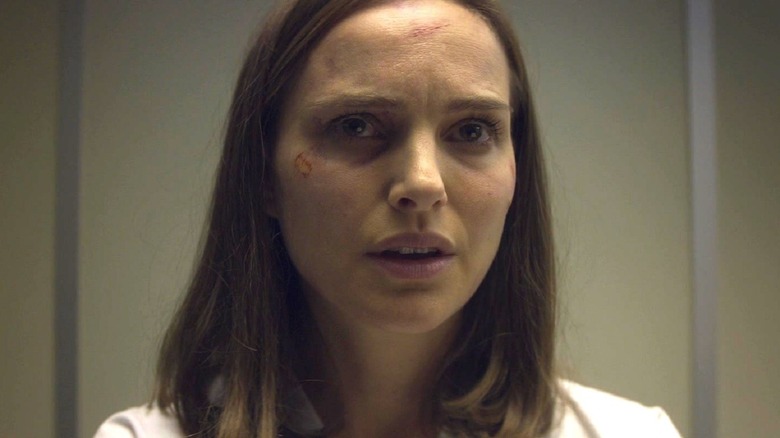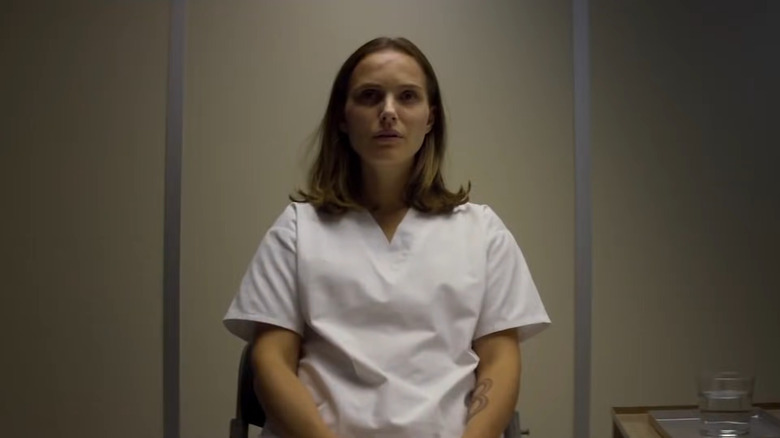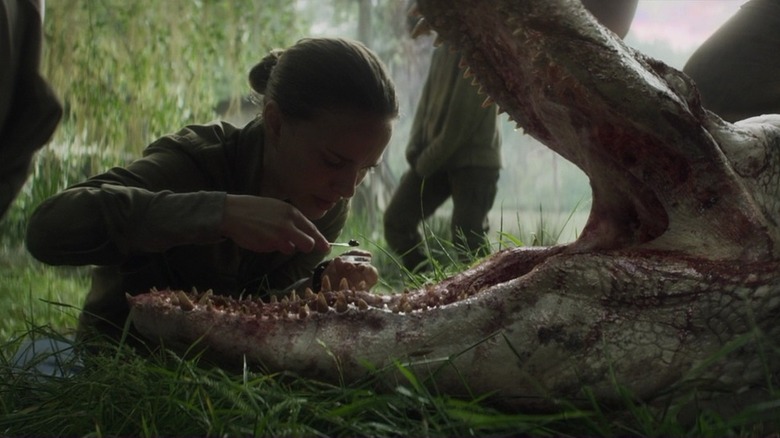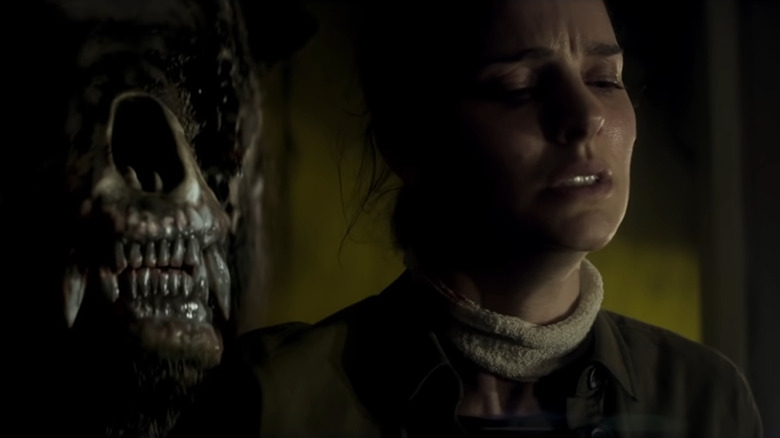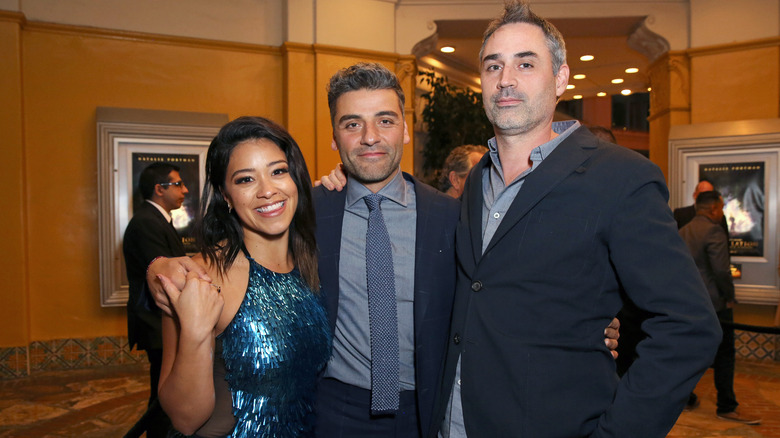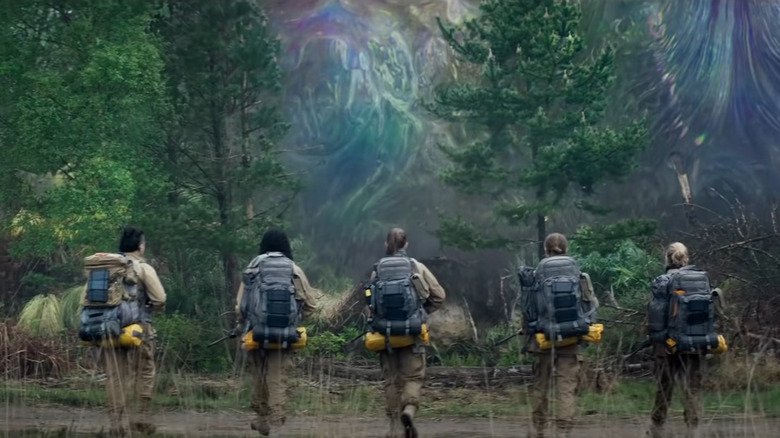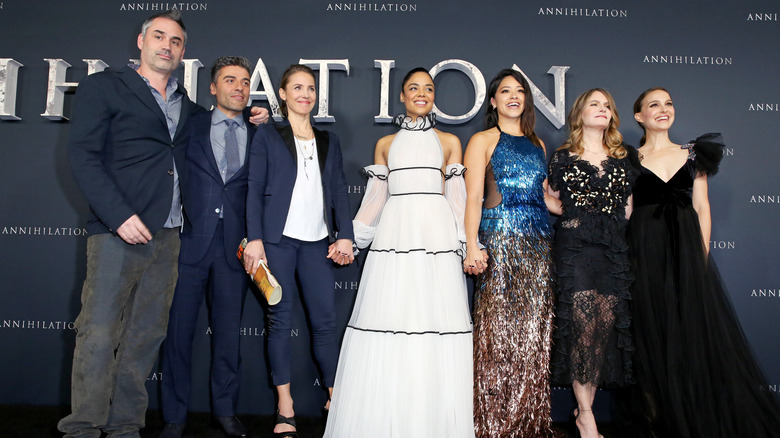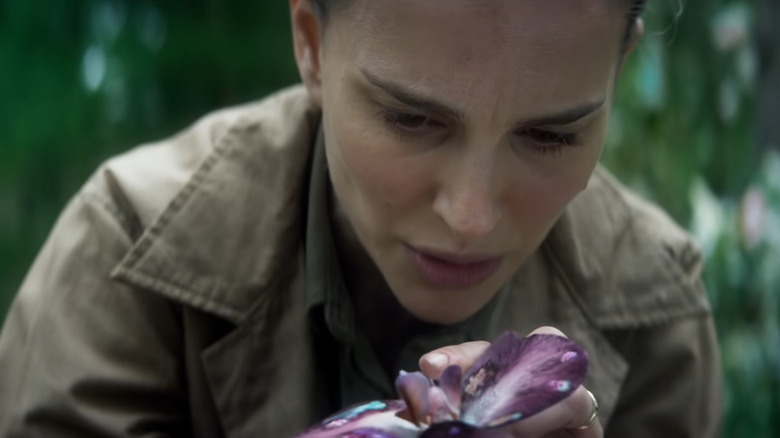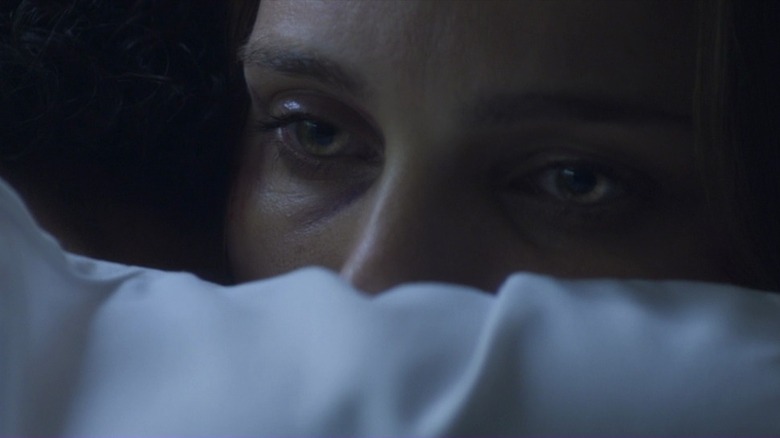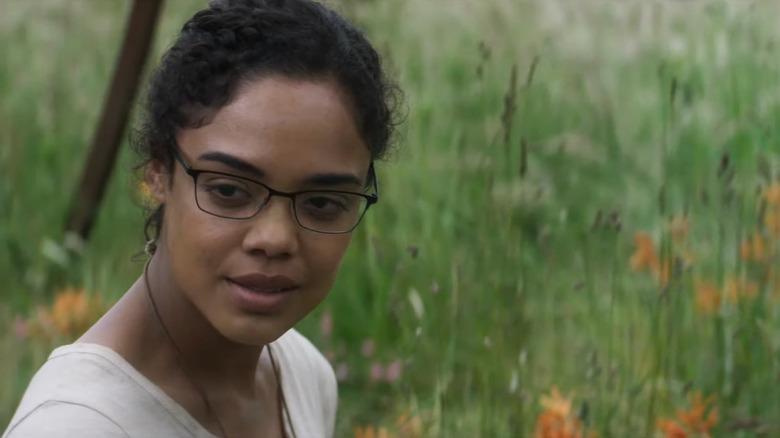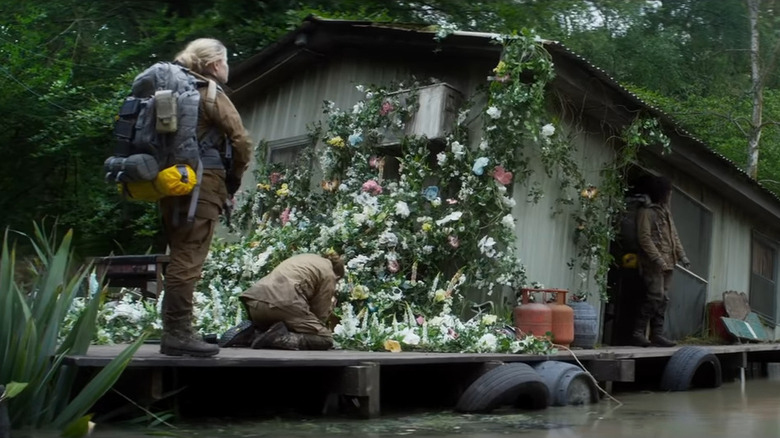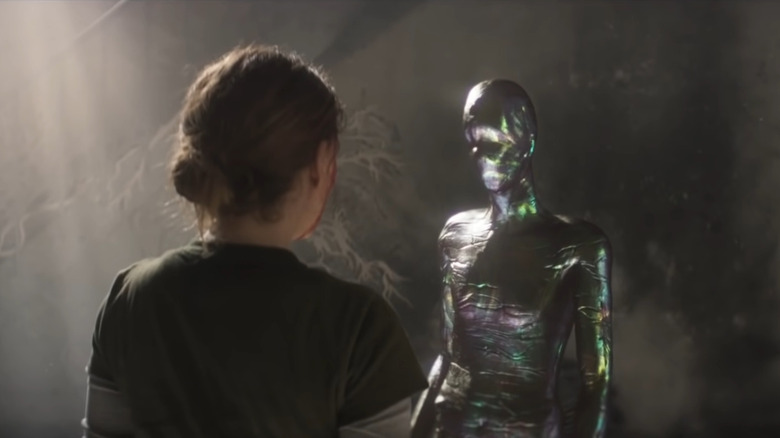The Untold Truth Of Annihilation
Alex Garland once described his second film, "Annihilation," as a "journey from suburbia to psychedelia" (via Collider). The 2018 film follows Lena (Natalie Portman), a biologist and Army veteran who learns her husband, Kane, (Oscar Isaac) was the only survivor of a secretive special forces mission. Determined to find out what happened to her husband, Lena joins an expedition into "the Shimmer," an expanding zone of unknown origin from which her husband somehow escaped. Lena is joined by a cryptic psychologist (Jennifer Jason Leigh), a sarcastic paramedic (Gina Rogriguez), a dreamy physicist (Tessa Thompson), and a geomorphologist (Tuva Novotny) who's recently suffered a devastating loss.
Each character in the film goes through some sort of emotional struggle, and their inner turmoil is in many ways reflected by the environment in which they find themselves. The Shimmer is filled with mutated plants and animals that perplex and terrify the team of scientists. But it's not just the external dangers they must face –- the women begin to suspect they're beginning to mutate themselves.
"Annihilation" is a complex, layered, profound meditation on the nature of the human instinct for self-destruction, and there's plenty to unpack on a thematic level. But there's also a wealth to discover about the making of the film, which is exactly what we're here to discuss. Keep reading to discover all the fascinating facts behind the making of "Annihilation." Warning — there are spoilers below.
Producers fought over making changes to the final cut
"Annihilation" is a perplexing, sophisticated, thought-provoking film — attributes that didn't necessarily endear it to Hollywood's top business executives. In fact, "Annihilation" came close to being adjusted in order to appeal to a wider audience. According to The Hollywood Reporter, there was a behind-the-scenes clash about the film's final edit. As the story goes, Skydance Productions head David Ellison became concerned that the movie was too heady for the average viewer following a test screening in July 2016. Following the screening, Ellison pushed to make changes to the film. As The Hollywood Reporter puts it, "They included making Portman's character more sympathetic as well as tweaking the ending."
On the other side of the conflict was Scott Rudin, who also executive produced "Ex Machina." Rudin sided with Garland's version of the film, and since Rudin had say over the final cut, Ellison's proposed changes were rejected. The conflict didn't stop here, however, as Paramount –- worried the film about the film's box office potential – decided to collaborate with Netflix to cover budget costs and limit the film's theatrical release.
All of these discussions happened on the business side of things, an arena in which Garland himself didn't have much say. When Collider asked Garland about his thoughts on the film being released internationally on Netflix (rather than in theaters), he certainly had an opinion on the matter. His response to the news? "Disappointment really. We made the film for cinema."
There were stand-ins for all of the mutated creatures
One of the most spellbinding elements of "Annihilation" is its incredible visual effects. From the jungle-like, rainbow-colored landscape of the Shimmer to the terrifying creatures that live within, the film is a visual marvel. And according to VFX supervisor Andrew Whitehurst (who also collaborated with Alex Garland on "Ex Machina"), working on the film was a unique process.
Whitehurst told VFX Voice that one of the most important elements of the film's special effects was the fact that there were stand-ins for all of the creatures seen on screen. "Even though this created more work for VFX, in terms of having to paint things out, what we gained in terms of lighting and composition from having a physical object on set was tremendous," he explained.
Having these so-called "physical presences" on set was paramount to the choreography and blocking of scenes as well, Whitehurst said. This also allowed director of photography Rob Hardy to light the scene perfectly in real-time, casting shadows around the creatures (or their stand-ins). Whitehurst went on to explain how this strategy also influenced the editing process. "I've noticed on VFX films that there is a strong tendency for scenes to be cut faster and faster when there's nothing yet comped into the frame," Whitehurst said. Already having that physical presence in the shot helps editors keep the pace of a scene more naturally, Whitehurst argued.
One of the mutated creatures actually scared the cast
The VFX team on "Annihilation" were able to use physical stand-ins for all the mutated creatures in the film — including that horrifying bear — and the result of all their hard work is amazing to witness. In one case, however, the practical effects scared the cast just as much as they scared the audience. In an interview with Collider, Natalie Portman confirmed that Alex Garland once surprised the cast with an animatronic creature that they hadn't seen before, meaning the screams they all emitted were very real. (We're assuming the animal in question was the horrifying bear creature.)
In the end, Portman said, "I'm not even sure they were able to use [the take] because I think we were all like 'ahhhhh!' — not necessarily the kind of tough, soldier reaction we were supposed to have." The bear is scary enough on screen, so we can't imagine how terrifying it would be to encounter in real life, even before it had been stylized with CGI. Thankfully, Portman has no hard feelings towards Garland for pulling that little trick. "It's always fun as long, as you know, nobody has a heart attack," she joked.
Alex Garland adapted the film before the book trilogy was finished
"Annihilation" is adapted from a book by Jeff VanderMeer — the first installment in his "Southern Reach Trilogy." However, Alex Garland signed on to do the film before the second and third books were even published, and he was never interested in the sequels. "I think I signed up for the others, but I always said at the same time, 'Look, I'm signing it, but I'm never going to do it,'" he told The Verge. He explained his position further, telling Collider, "I'm more interested in telling contained stories."
However, this decision did get him in a bit of hot water for a time. Following the release of the film's trailer, "Annihilation" was criticized by the Media Action Network for Asian Americans (MANAA) for whitewashing Natalie Portman's character, who's described as being of Asian descent in the books. In response to the backlash, Garland explained that the races of the characters aren't acknowledged in the first novel, which is the only one he read prior to making the film. (Lena's race isn't mentioned until the second book.)
Garland told Deadline, "As a middle-aged white man, I can believe I might at times be guilty of unconscious racism, in the way that potentially we all are. But there was nothing cynical or conspiratorial about the way I cast this movie." Portman was also unaware of the issue until it was brought up in an interview with Yahoo! Entertainment.
Garland wanted everything in the Shimmer to feel truly alien
Alex Garland was keen to create something entirely new within the lush world of "Annihilation," and he did this by thinking about how the film's alien elements would appear. Garland told Collider, "We wanted to do something truly alien," also saying, "That had all sorts of elements to it — not just about how something physically appears, but also about what it is and how it acts and separating it completely from the way we act."
The look and feel of the organisms within the Shimmer were important to Garland, but so were the motivations behind this so-called alien invasion. "[I didn't want] to make human type assumptions about it in terms of motivation," he said, "like it wants to steal our resources or take us back to the galactic federation or anything like that." The audience never really knows why these alien forces have come to Earth, nor are we ever cued into what their intentions are. Is this genetic mutation an inherently malevolent force?
While the film is disturbing in many ways, Garland doesn't see it as a misanthropic or depressive story, despite its dramatic title. "It's definitely not cynical at all. It's actually quite heartfelt. It has elements of sadness and melancholy in it, but there's also a visceral propulsion to it," Garland explained. Whether the events of the film are primarily a positive or a negative force is up to each viewer to decide for themselves.
The casting process varied for each actor
The cast of "Annihilation" may have come together perfectly, but the process was different for every actor involved. Speaking with The Ringer, Alex Garland said Oscar Isaac was an obvious choice because of his talent and the fact they'd worked together before on "Ex Machina." Garland had never worked with Natalie Portman prior to shooting, but he knew she would be perfect for the part having seen many of the films in Portman's repertoire. Garland saw a unique quality in her that he wanted to capture on film. "She has enormous poise and a sense of control, but she also has the ability to, within that sense of poise and control, display glimpses, flashes, and then great explosions of damage," he explained.
For the rest of the actors — Tessa Thompson, Gina Rodriguez, Tuva Novotny, and Jennifer Jason Leigh — Garland said, "It was much more just old-fashioned casting." He fondly recalls the experience of seeing Thompson audition for the first time. "She gave an absolutely unbelievable reading, and she was so smart and articulate, and the performance was really ... it was so precise, but also so ... generous, and free-spirited in a funny way," Garland put it. He knew Thompson was perfect for the part right away, and the rest, as they say, was history.
Scientific accuracy was very important to Alex Garland
It's totally possible to enjoy (and even understand) "Annihilation" without any scientific expertise, but that doesn't mean the film skimps on scientific accuracy either. According to Alex Garland's scientific advisor, British geneticist Dr. Adam Rutherford, Garland is extremely dedicated to getting the science right in his films. Rutherford told IndieWire that what Garland cares about most is "really grounded science fiction."
For "Annihilation," this meant a lot of intense conversations about the nature of genetics and foundational scientific principles, as well as a detailed run-through of the script for scientific accuracy. "There isn't a line in 'Annihilation' or 'Ex Machina' that isn't based on decades of research and scientific understanding," Rutherford explained. Rutherford described the science of "Annihilation" like this: "None of it is bull****, but it's fiction, if that makes sense." Rutherford has a particular disdain for science fiction movies where scientist characters deliver nonsensical lines, which is why he appreciates Garland's obsession with ensuring every line is based on scientific fact.
Rutherford also acted as a resource for the actors so they could better understand their characters. They would ask him questions about how he thinks based on his experience as a scientist, which was an oddly flattering experience for him. "When you're sitting across from Tessa Thompson and she's asking you about your life, it's pretty f****** cool," he explained.
An ancient philosophical paradox helps explain the film's ending
There are several different ways to interpret the ending of "Annihilation." One explanation is that the Lena at the end of the film isn't the Lena who first entered the Shimmer — her alien duplicate has replaced her, while the "original" Lena was left behind. A more ambiguous take would be that the Lena at the end of the film isn't the Lena from the start of the film, but she's not an entirely new Lena either — she's just been extensively mutated due to her time in the Shimmer. Or, perhaps it doesn't really matter either way.
Director Alex Garland has been hesitant to spell things out, but he did offer a simple way to consider the film's ending. Garland told Thrillist that you can think of the ending of "Annihilation" through the lens of an ancient Greek philosophical paradox called the Ship of Theseus. Garland explains the parable like this: "You take all the wooden planks out, you put them in another ship, you build another ship, and by the end of it, you've got a perfect facsimile, and then everyone wonders — which is the Ship of Theseus, and which is the copy?"
Of course, the idea is that there are multiple answers to the question, each of which is in some sense "correct." Garland, of course, prefers the interpretation that's the most complex. "I quite like the version where it's both," he explained.
The hot tub story
Most of "Annihilation" was filmed outside in nature, which led to a unique filming experience for the cast and crew. Jennifer Jason Leigh told /Film that they spent most of their time in between takes sitting in a tent in the forest, eating a lot of nuts and raisins because most of the cast was vegan. "It was an insane experience but really fun and great group of women," she explained.
For the film's star, Natalie Portman, one of her most memorable days of shooting also involved a bizarre experience in nature. As she told Collider, one of her favorite days was a scene she filmed with Tessa Thompson where they were in and out of the water all day. In order to ensure that they were kept warm enough and their bodies wouldn't go into shock due to drastic changes in temperature, the crew set up a hot tub for Portman and Thompson to sit in while they weren't shooting.
"We were like fully clothed in military gear going in like a hot tub together in between takes, and we were like, 'This is an interesting day of work,'" Portman explained. Portman called that day a "highlight" and recalled a lot of laughter during the shooting process.
The backstory for Tessa Thompson's character
Apart from Lena (whose own backstory remains somewhat murky), we're not given a lot of insight into what the characters' lives were like before they entered the Shimmer. We eventually learn key details — Josie has struggled with self-harm, Anya is a recovering alcoholic, Cass lost a child, and Dr. Ventress has cancer — but there's still a lot we don't know.
Despite the mysteriousness of the script, Tessa Thompson was keen to understand the experiences of her character better. One of the ideas she eventually landed on was the fact that her character, Josie, is a virgin. The idea came about when she was improvising a line with her scene partner, Gina Rodriguez, who came up with the idea to tease Josie about never having been kissed. Rodriguez wasn't sure if the scene would work or if it was in line with Garland's vision of Josie, so Thompson decided to ask him. "So I asked Alex, 'Is she a virgin?' And he was like, 'Yeah. I always thought of her that way,'" she recalled to Elle.
In this case, the director and actor's ideas about the character aligned perfectly, though Garland has previously said he's happy to let his actors find their own interpretation of the characters once they have the script in hand.
Production design turned English parkland into the Shimmer
Based on the location described in the original novel, the Shimmer is supposed to be somewhere in the southern United States, specifically a coastal region. You probably wouldn't guess it from watching the film, but "Annihilation" was actually filmed in England, in an area of parkland near the famous Pinewood Studios. In a New York Times "Anatomy of Scene" video, Alex Garland explained how the design of the Shimmer came to be.
One of the most important elements early on is the fishing hut the team encounters after they first enter the Shimmer. Set decorator Michelle Day came up with the dilapidated, sunken design of the hut, which was in direct contrast to the initial idea of a more quaint-looking abode. The hut looked even more striking considering the beautiful, lush, green environment in which it was placed.
In regards to the natural landscape of the Shimmer, Garland said, "Most of what you see there, in some respects, is constructed." He explained that much of the visible foliage was placed there by set decorators so that the Shimmer looked nothing like England and instead more like mutated, twisted coast in the American South.
There's a dance connection between Annihilation and Ex Machina
"Annihilation" might not seem like it has much to do with dancing, but there's actually a dance connection between "Annihilation" and Alex Garland's previous film, "Ex Machina." If you've seen "Ex Machina," you probably remember the creepy disco dance performed by Oscar Isaac and Sonoya Mizuno. There's no way you'd know this just by looking at her, but Mizuno is actually the star of one of the most pivotal scenes in "Annihilation." When Lena finally reaches the lighthouse near the end of the film, she encounters a horrifying, metallic humanoid figure. The figure begins mirroring all of Lena's movements and eventually morphs into an exact facsimile of Lena herself.
That metallic figure, if you hadn't already guessed, is played by Mizuno. (Mizuno is also featured in the background as a med student earlier in the film.) Garland told The Ringer that Mizuno was an obvious choice for the role, saying "[She] is an incredibly gifted actor but also incredibly gifted dancer and can communicate an enormous amount physically." You might not think of this harrowing moment as a dance scene, but it did actually require a choreographer.
Interestingly enough, the film's choreographer also has a connection to the film's cast, as Nerdist reported. The choreographer was Israeli dancer Bobbi Jene Smith. Smith was featured in a documentary called "Bobbi Jene," which was directed by Danish documentarian Elvira Lind. Lind's husband? "Annihilation" star Oscar Isaac.
